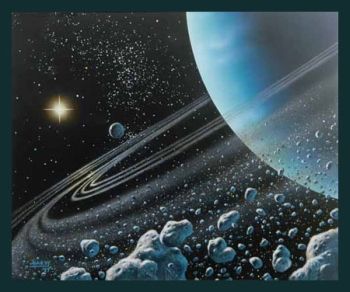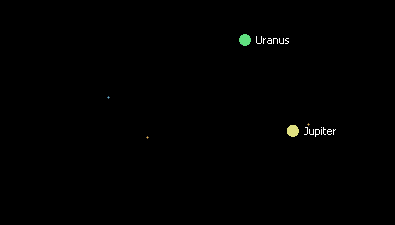
Publisher:
Bonnie King
CONTACT:
Newsroom@Salem-news.com
Advertising:
Adsales@Salem-news.com

~Truth~
~Justice~
~Peace~
TJP
Oct-06-2010 19:30

 TweetFollow @OregonNews
TweetFollow @OregonNews
The Planets: Finding Uranus
Daniel Johnson Salem-News.comThis is a particularly easy time to find Uranus because it is in a field where there are few other stars to cause confusion.
 Uranus Rings by David A Hardy image courtesy: Dakota’s Weird Blog |
(CALGARY, Alberta) - The solar system has eight “official” planets although some still consider Pluto to be a planet. Looking only at the “official” list, from the Sun outwards, there is Mercury, Venus, Earth, Mars, Jupiter, Saturn, Uranus and Neptune.
All eight are readily visible to the naked eye or binoculars Right now Mercury, Venus, Mars and Saturn are too close to the Sun to be visible. Venus is bright enough so that if you know where to look it can be spotted with the naked eye during the day.
I know this is possible, because I have done it. Venus’s maximum magnitude is about the same as the International Space Station when it is fully lit by the Sun.
My focus in this article is to help you find Uranus, which is currently very close to Jupiter.
Finding Jupiter is dead easy. At midnight Salem time, it’s due south, very high in the sky. But you don’t have to stay up late, at 9pm it’s very high in the SE and the brightest object in the sky. You can’t miss it.
Finding Uranus is similarly easy. You don’t even need a really dark sky. I find it easily from my apartment balcony in downtown Calgary.
If you can get to a place away from lights, it will be easier for you to find. Outside the city is best.

Jupiter and Uranus are less than 2º apart and, depending on the power of your binoculars, they could both be in the field of view at the same time.
Uranus is at magnitude 5.7 and Jupiter at –2.9; Jupiter is 2,755 times brighter than Uranus.
This is a particularly easy time to find Uranus because it is in a field where there are few other stars to cause confusion.
In principle, Uranus is visible to the naked eye.
This is not possible in this example because Jupiter is so bright, it will drown out Uranus’s feeble light.
The star map shows the magnitude of seven stars in the field. Uranus is easily found in this uncrowded star field.
On to Neptune
Neptune is more of a challenge and will require familiarity with, and use of a star chart. It is much fainter than Uranus, at 7.9, Uranus being about 7.5 times brighter.
Neptune is very close to Mu Capricorni,—about a quarter of a degree away. With a star chart, you can navigate in the region until you find Mu Capriconi and Neptune is close. A pair of 7x50 binoculars should be adequate. The faintest magnitude under ideal conditions with 7x50 binoculars is 9.5 so that under ordinary dark skies, you should be able to see Neptune. Mu Capricorni is about 13 times brighter than Neptune.

A note about magnitude for the mathematically inclined Magnitude is obviously the brightness of a celestial object. The idea originated with the ancient Greeks who divided the stars visible to the naked eye into six magnitudes where the brightest stars were at magnitude 1 and the faintest stars visible to the naked eye were 6. Using this classification, the higher the magnitude, the fainter the object.
In the nineteenth century this was formalized to mean that a 1st magnitude star was 100 times brighter than a 6th magnitude star. Each magnitude is 2.512 times brighter than the next; eg., from 1st to 2nd magnitude.
The system is no longer limited to six numbers and objects brighter than the brightest stars are given negative magnitudes. The Sun, for example, has a magnitude of –26 and the moon –12. The Sun is a `bout 400,00 times brighter than the full moon. Sirius (the Dog Star), the brightest star in the sky, is 23 times brighter than Polaris (the North Star).
For the mathematically inclined, the magnitude scale is logarithmic and comparisons are calculated using the ratio 2.512 as the base. For example, the magnitude of Jupiter is –2.9 and Uranus is 5.7. The variation in brightness is found with this formula where x is the power to use.
x = Magnitude of brighter object minus magnitude of dimmer object
For Jupiter and Uranus, x = (-2.9) – 5.7 = 8.6
variation = 2.5128.6 = 2,755
for Neptune and Mu Capricorni x = 5.09 – 7.9 = 2.81
variation = 2.5122.81 = 13.306
For the Sun and the moon x = (-12.74) – (-26.74) = 14
variation = 2.51214 = 398,359
 Daniel Johnson was born near the midpoint of the twentieth century in Calgary, Alberta. In his teens he knew he was going to be a writer, which is why he was one of only a handful of boys in his high school typing class — a skill he knew was going to be necessary. He defines himself as a social reformer, not a left winger, the latter being an ideological label which, he says, is why he is not an ideologue. From 1975 to 1981 he was reporter, photographer, then editor of the weekly Airdrie Echo. For more than ten years after that he worked with Peter C. Newman, Canada’s top business writer (notably on a series of books, The Canadian Establishment). Through this period Daniel also did some national radio and TV broadcasting. He gave up journalism in the early 1980s because he had no interest in being a hack writer for the mainstream media and became a software developer and programmer. He retired from computers last year and is now back to doing what he loves — writing and trying to make the world a better place
Daniel Johnson was born near the midpoint of the twentieth century in Calgary, Alberta. In his teens he knew he was going to be a writer, which is why he was one of only a handful of boys in his high school typing class — a skill he knew was going to be necessary. He defines himself as a social reformer, not a left winger, the latter being an ideological label which, he says, is why he is not an ideologue. From 1975 to 1981 he was reporter, photographer, then editor of the weekly Airdrie Echo. For more than ten years after that he worked with Peter C. Newman, Canada’s top business writer (notably on a series of books, The Canadian Establishment). Through this period Daniel also did some national radio and TV broadcasting. He gave up journalism in the early 1980s because he had no interest in being a hack writer for the mainstream media and became a software developer and programmer. He retired from computers last year and is now back to doing what he loves — writing and trying to make the world a better place
Articles for October 5, 2010 | Articles for October 6, 2010 | Articles for October 7, 2010
Quick Links
DINING
Willamette UniversityGoudy Commons Cafe
Dine on the Queen
Willamette Queen Sternwheeler
MUST SEE SALEM
Oregon Capitol ToursCapitol History Gateway
Willamette River Ride
Willamette Queen Sternwheeler
Historic Home Tours:
Deepwood Museum
The Bush House
Gaiety Hollow Garden
AUCTIONS - APPRAISALS
Auction Masters & AppraisalsCONSTRUCTION SERVICES
Roofing and ContractingSheridan, Ore.
ONLINE SHOPPING
Special Occasion DressesAdvertise with Salem-News
Contact:AdSales@Salem-News.com

googlec507860f6901db00.html



Terms of Service | Privacy Policy
All comments and messages are approved by people and self promotional links or unacceptable comments are denied.
JT October 11, 2010 9:36 pm (Pacific time)
Sorry, dumb question, but regarding the moon "landings", do you really believe they were faked or were you being sarcastic?
My apologies. It's not a dumb question. I wasn't trying to be sarcastic, just light hearted.
Were you able to spot Uranus?
Natalie October 7, 2010 12:23 am (Pacific time)
Didn't they make it official to consider the solar system a 12 planets system by adding 3 more planets-Xena, Charon and something else?...forgot the name...it happened this past spring or somewhere around that time.
Natalie: There is both confusion and some acrimony around the concept of"what is a planet?" The International Astronomical Union (IAU) recornizes the eight planets but acknowledges what are referred to as dwarf planets, like Pluto, Ceres and Eris. Pluto, for example, is only one of thousands of similar objects orbiting in that region called the Kiuper Belt. Charon, which you mentioned, is an even tinier object revolving around Pluto. Dwarf planets aside, some argue that having a satellite of its own, as Pluto does, should make it a planet in the traditional sense.
Josh Akers October 6, 2010 10:01 pm (Pacific time)
So I heard there's a base on the moon already. Anyone care to break wind on that topic?
It's completely possible. Who here really believes what they're told? NASA abandoned the moon? Our closest celestial object, capable of being taken advantage of by any space racing corporation... Of course there are elements there worthy of mining, we already found water, which is a compound of 2 elements. Something's going on up there.
There is one satellite orbiting the moon, according to NASA, and no humans anywhere around... PFFFT, I say.
What a bunch of nonsense, Josh. Knowledgeable people know that the moon "landings" were faked. It was all done on a sound stage in southern California. DJ
JT October 6, 2010 9:08 pm (Pacific time)
Time for some planet gazing :) Thanks for the info!
[Return to Top]©2025 Salem-News.com. All opinions expressed in this article are those of the author and do not necessarily reflect those of Salem-News.com.